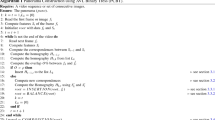Abstract
The last data on the search results for neutrino oscillations in the OPERA experiment and the completed modernization of the PAVICOM facility (Lebedev Physical Institute) for automatic processing of nuclear emulsions of this experiment are presented. A new test application is developed for the PAVICOM to perform all stages of image processing. The application is tested using a GTX570 video card. The processing time for one frame is significantly reduced, which made it possible tomore than tenfold speed up processing. This is of crucial importance not only for prompt acquisition of statistically significant data of the OPERA experiment, but also for planned works on muon radiography.
Similar content being viewed by others
References
S. A. Durrani and R. K. Bull, Solid State Nuclear Track Detection: Principles, Methods, and Applications (Pergamon Press, Oxford, 1987; Energoatomizdat, Moscow, 1990).
N. G. Polukhina, Usp. Fiz. Nauk 182(2), 656 (2012).
N. Agafonova et al., New J. Phys. 14, 013026 (2012).
I. M. Dremin, O. V. Ivanov, S. A. Kalinin, et al., Phys. Lett. B 499, 97 (2001).
N. G. Polukhina, Doctoral Dissertation in Physics and Mathematics (FIAN, Moscow, 2006).
V. L. Ginzburg, N. G. Polukhina, I. I. Starkov, et al., Dokl. Akad. Nauk 402(4), 1 (2005) [Dokl. Phys. 50, 283 (2005)].
R. Acquafredda, T. Adam, V. Nikitina, et al., JINST 4(6), 20 (2009).
N. Agafonova, A. Aleksandrov, O. Altinok, et al. (OPERA Collab.), Phys. Lett. B 691, 138 (2010).
N. Agafonova et al., New J. Phys. 14, 033017 (2012).
V. Tioukov et al., Nucl. Instrum. Meth. A 559, 103 (2006).
A. Aleksandrov and V. Tioukov, Submitted to Nucl. Instrum. Meth. A.
N. Armenise et al., Nucl. Instrum.Meth. A 551, 261 (2005).
Author information
Authors and Affiliations
Corresponding author
Additional information
Original Russian Text © A.B. Aleksandrov, M.S. Vladimirov, N.G. Polukhina, N.I. Starkov, T.V. Shchedrina, 2012, published in Kratkie Soobshcheniya po Fizike, 2012, Vol. 39, No. 9, pp. 38–50
About this article
Cite this article
Aleksandrov, A.B., Vladimirov, M.S., Polukhina, N.G. et al. System for processing emulsion data of the OPERA experiment using the PAVICOM facility and prospects of its application to scan objects by muon radiography methods. Bull. Lebedev Phys. Inst. 39, 269–276 (2012). https://doi.org/10.3103/S1068335612090059
Received:
Published:
Issue Date:
DOI: https://doi.org/10.3103/S1068335612090059




